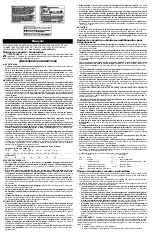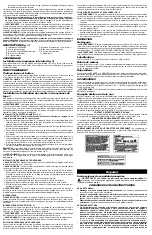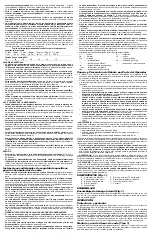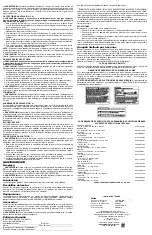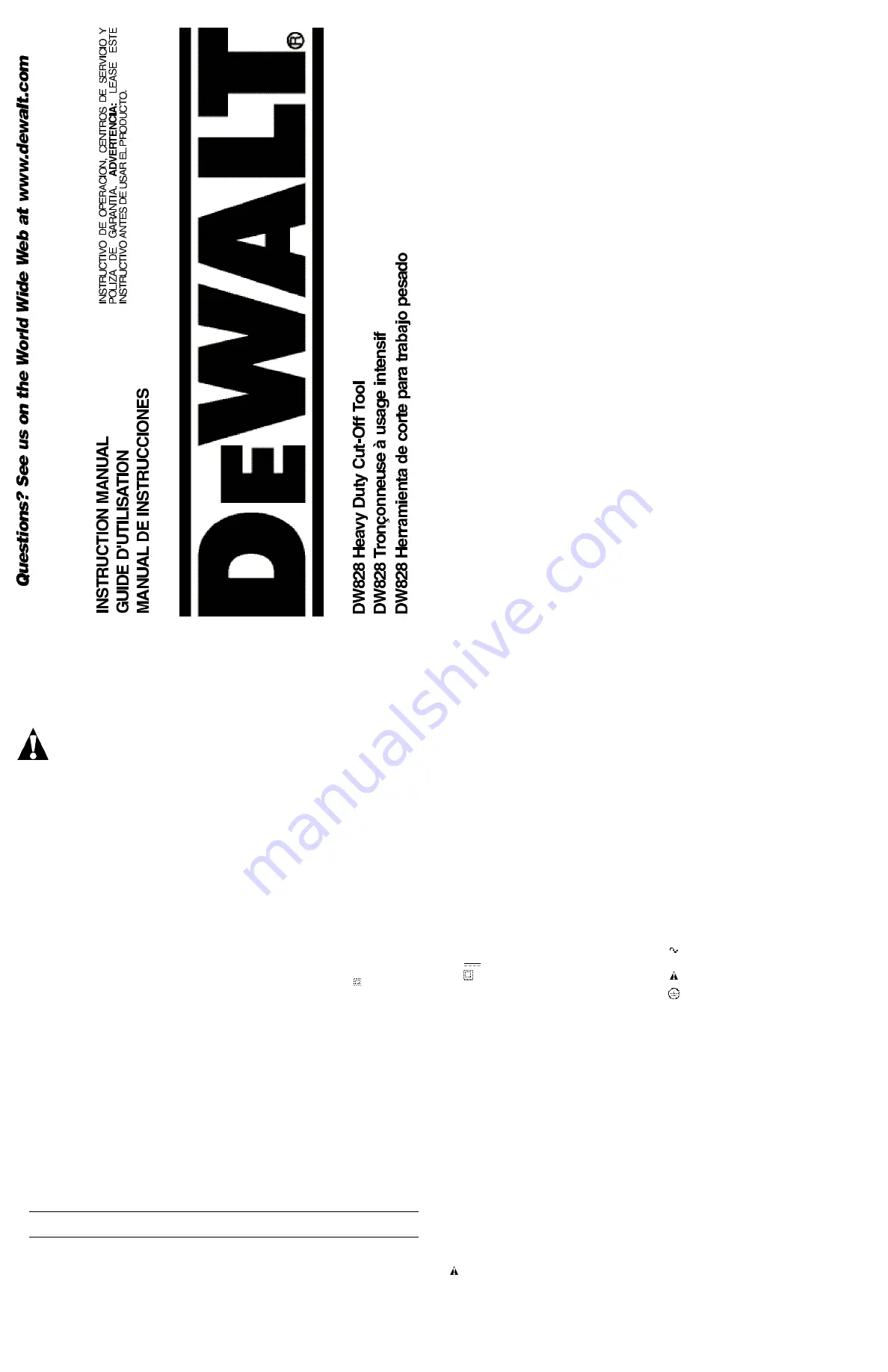
D
E
WA LT Industrial Tool Co., 701 East Joppa Road, Baltimore, MD 21286
(FEB04 CD1)
Form No. 622422-00 DW828 Copyright © 2004
The following are trademarks for one or more D
E
WA LT power tools: the yellow and black color scheme;
the “D” shaped air intake grill; the array of pyramids on the handgrip; the kit box configuration; and the
array of lozenge-shaped humps on the surface of the tool.
IF YOU HAVE A N Y QUESTIONS OR COMMENTS A B O U T THIS OR A N Y D
E
WA LT TO O L ,
C A L L US TO L L FREE AT:
1 - 8 0 0 - 4 - D
E
WA LT (1-800-433-9258)
General Safety Rules
WARNING! Read and understand all instructions.
Failure to follow all
instructions listed below may result in electric shock, fire and/or serious
personal injury.
SAVE THESE INSTRUCTIONS
WORK A R E A
•
Keep your work area clean and well lit.
Cluttered benches and dark areas invite accidents.
•
Do not operate power tools in explosive atmospheres, such as in the presence of
flammable liquids, gases, or dust.
Power tools create sparks which may ignite the dust or
f u m e s .
•
Keep bystanders, children, and visitors away while operating a power tool.
D i s t r a c t i o n s
can cause you to lose control.
E L E C T R I C A L S A F E T Y
•
Grounded tools must be plugged into an outlet properly installed and grounded in
accordance with all codes and ordinances. Never remove the grounding prong or
modify the plug in any way. Do not use any adapter plugs. Check with a qualified
electrician if you are in doubt as to whether the outlet is properly grounded.
If the tools
should electrically malfunction or break down, grounding provides a low resistance path to
carry electricity away from the user.
Applicable only to Class I (grounded) tools.
•
Double insulated tools are equipped with a polarized plug (one blade is wider than the
o t h e r.) This plug will fit in a polarized outlet only one way. If the plug does not fit fully in
the outlet, reverse the plug. If it still does not fit, contact a qualified electrician to install
a polarized outlet. Do not change the plug in any way
. Double insulation
eliminates the
need for the three wire grounded power cord and grounded power supply system.
A p p l i c a b l e
only to Class II (double insulated) tools.
•
Avoid body contact with grounded surfaces such as pipes, radiators, ranges and
r e f r i g e r a t o r s .
There is an increased risk of electric shock if your body is grounded.
•
D o n ’t expose power tools to rain or wet conditions.
Water entering a power tool will
increase the risk of electric shock.
•
Do not abuse the cord. Never use the cord to carry the tools or pull the plug from an
outlet. Keep cord away from heat, oil, sharp edges or moving parts. Replace damaged
cords immediately.
Damaged cords increase the risk of electric shock.
•
When operating a power tool outside, use an outdoor extension cord marked “W-A” or
“ W.”
These cords are rated for outdoor use and reduce the risk of electric shock. When using
an extension cord, be sure to use one heavy enough to carry the current your product will
d r a w. An undersized cord will cause a drop in line voltage resulting in loss of power and
overheating. The following table shows the correct size to use depending on cord length and
nameplate ampere rating. If in doubt, use the next heavier gage. The smaller the gage
n u m b e r, the heavier the cord.
Recommended Minimum Wire Size for Extension Cords
Total Length of Cord
25 ft.
50 ft.
75 ft.
100 ft.
125 ft.
150 ft.
175 ft.
7.6 m 15.2 m
22.9 m
30.5 m
38.1 m 45.7 m
53.3 m
Wire Size AW G
1 8
1 8
1 6
1 6
1 4
14
1 2
P E R S O N A L S A F E T Y
•
Stay alert, watch what you are doing and use common sense when operating a power
tool. Do not use tool while tired or under the influence of drugs, alcohol, or medication.
A moment of inattention while operating power tools may result in serious personal injury,
•
Dress properly. Do not wear loose clothing or jewelry. Contain long hair. Keep your
h a i r, clothing, and gloves away from moving parts.
Loose clothing, jewelry, or long hair
can be caught in moving parts. Air vents often cover moving parts and should also be avoided.
•
Avoid accidental starting. Be sure switch is off before plugging in.
Carrying tools with
your finger on the switch or plugging in tools that have the switch on invites accidents.
•
Remove adjusting keys or wrenches before turning the tool on.
A wrench or key that is
left attached to a rotating part of the tool may result in personal injury.
•
Do not overreach. Keep proper footing and balance at all times.
Proper footing and
balance enables better control of the tool in unexpected situations.
•
Use safety equipment. Always wear eye protection.
Dust mask, non-skid safety shoes,
hard hat, or hearing protection must be used for appropriate conditions.
TO O L USE AND CARE
•
Use clamps or other practical way to secure and support the workpiece to a stable
platform.
Holding the work by hand or against your body is unstable and may lead to loss of
c o n t r o l .
•
Do not force tool. Use the correct tool for your application.
The correct tool will do the job
better and safer at the rate for which it is designed.
•
Do not use tool if switch does not turn it on or off .
Any tool that cannot be controlled with
the switch is dangerous and must be repaired.
•
Disconnect the plug from the power source before making any adjustments, changing
accessories, or storing the tool.
Such preventative safety measures reduce the risk of
starting the tool accidentally.
•
Store idle tools out of reach of children and other untrained persons.
Tools are
dangerous in the hands of untrained users.
•
Maintain tools with care. Keep cutting tools sharp and clean.
Properly maintained tools,
with sharp cutting edges are less likely to bind and are easier to control.
•
Check for misalignment or binding of moving parts, breakage of parts, and any other
condition that may affect the tools operation. If damaged, have the tool serviced before
u s i n g .
Many accidents are caused by poorly maintained tools.
•
Use only accessories that are recommended by the manufacturer for your model.
Accessories that may be suitable for one tool, may become hazardous when used on another
t o o l .
S E RV I C E
•
Tool service must be performed only by qualified repair personnel.
Service or
maintenance performed by unqualified personnel could result in a risk of injury.
•
When servicing a tool, use only identical replacement parts. Follow instructions in the
Maintenance section of this manual.
Use of unauthorized parts or failure to follow
Maintenance Instructions may create a risk of electric shock or injury.
Additional Specific Safety Instructions for Cut-Off To o l s
•
Always use proper guard with grinding wheel.
A guard protects operator from broken
wheel fragments and wheel contact.
•
Accessories must be rated for at least the speed recommended on the tool warning
l a b e l .
Wheels and other accessories running over rated speed can fly apart and cause
i n j u r y. Accessory ratings must be above listed minimum wheel speed as shown on tool
n a m e p l a t e .
•
Hold tool by insulated gripping surfaces when performing an operation where the
cutting tool may contact hidden wiring or its own cord.
Contact with a “live” wire will
make exposed metal parts of the tool “live” and shock the operator.
•
Do not use Type 11 (flaring cup) wheels on this tool.
Using inappropriate accessories
can result in injury.
•
Use only 6" x 1/8" or less thick cutting wheels on this tool.
Using other accessories is
not recommended and may cause injury and tool damage.
•
Always use Type 1 guard with cutting wheel.
A guard protects operator from broken
wheel fragments and wheel contact. Type 1 guards cover both sides of the wheel and offer
maximum protection for cutting operation.
•
A LWAYS WEAR EYE PROTECTION WHEN USING THIS TO O L .
•
Use of accessories not specified in this manual is not recommended and may be
hazardous.
Use of power boosters that would cause the tool to be driven at speeds greater
than its rated speed constitutes misuse.
•
Do not use circular saw blades or any other toothed blades with this tool.
S e r i o u s
injury may result.
•
Before using, inspect recommended accessory for cracks or flaws. If such a crack or
flaw is evident, discard the accessor y. The accessory should also be inspected
whenever you think the tool may have been dropped.
Flaws may cause wheel break -
age. Do not set unit down on wheel.
•
When starting the tool with a new or replacement wheel installed, or if you are unsure
of the condition of the wheel, hold the tool in a well protected area and let it run for
one minute.
If the wheel has an undetected crack or flaw, it should burst in less than one
minute. Never start the tool with a person in line with the wheel. This includes the operator.
•
Avoid bouncing the wheel or giving it rough treatment.
If this occurs, stop the tool and
inspect the wheel for cracks or flaws.
•
Direct sparks away from operator, bystanders or flammable materials.
Sparks may be
produced while cutting. Sparks may cause burns or start fires.
•
Always use side handle. Tighten the handle securely
. The side handle should always
be used to maintain control of the tool at all times.
•
Never cut into area that may contain electrical wiring or piping.
Serious injury may
r e s u l t .
•
Clean out your tool often, especially after heavy use.
Dust and grit containing metal par -
ticles often accumulate on interior surfaces and could create an electric shock hazard.
•
Do not operate this tool for long periods of time.
Vibration caused by the operating
action of this tool may cause permanent injury to fingers, hands, and arms. Use gloves to
provide extra cushion, take frequent rest periods, and limit daily time of use.
• The label on your tool may include the following symbols:
V . . . . . . . . . . . . . . . . . . . . . .v o l t s
A . . . . . . . . . . . . . . . . . . . .a m p e r e s
H z . . . . . . . . . . . . . . . . . . . .h e r t z
W . . . . . . . . . . . . . . . . . .w a t t s
m i n . . . . . . . . . . . . . . . . . .m i n u t e s
. . . . . . . . . . . . . . . . . .alternating current
. . . . . . . . . . . . . . . .direct current
no . . . . . . . . . . . . . . . . . .no load speed
. . . . . . . . . . . . . . . . . . . .Class II
. . . . . . . . . . . . . . . . . .safety alert symbol
. . . . . . . . . . . . . . . . . . . . . . . .
C o n s t r u c t i o n
. . . . . . . . . . . . . . . . . .earthing terminal
… / m i n . . . . . . . . . . . . . .revolutions per minute
s f p m . . . . . . . . . . . . . .surface feet per minute
Causes and Operator Prevention
of Kickback
•
Kickback is a sudden reaction to a pinched, bound or misaligned cutting wheel, causing an
uncontrolled cut-off tool to lift up and out of the workpiece toward the operator.
•
When the wheel is pinched or bound tightly by the workpiece, the wheel stalls and the motor
reaction drives the unit rapidly back toward the operator.
•
Kickback is the result of tool misuse and/or incorrect operating procedures or conditions
and can be avoided by taking proper precautions as given below:
•
Maintain a firm grip with both hands on the unit and position your body and arm
to allow you to resist kickback forces.
Kickback forces can be controlled by the oper -
a t o r, if proper precautions are taken.
•
When wheel is binding, or when interrupting a cut for any reason, release the trig -
ger and hold the unit motionless in the material until the wheel comes to a com -
plete stop. Never attempt to remove the unit from the work or pull the unit back -
ward while the wheel is in motion or kickback may occur.
Investigate and take cor -
rective actions to eliminate the cause of wheel binding.
•
When restarting a cut-off tool in the workpiece, check that the wheel is not
engaged into the material.
If wheel is binding, it may walk up or kickback from the work -
piece as the tool is restarted.
•
Support large panels to minimize the risk of wheel pinching and kickback.
L a r g e
panels tend to sag under their own weight. Support must be placed under the panel on
both sides, near the line of cut and near the edge of the panel.
WARNING:
Some dust created by power sanding, sawing, grinding, drilling, and other
construction activities contains chemicals known to cause cancer, birth defects, or other
reproductive harm. Some examples of these chemicals are:
• lead from lead-based paints,
• crystalline silica from bricks and cement and other masonry products, and
• arsenic and chromium from chemically-treated lumber (CCA).



